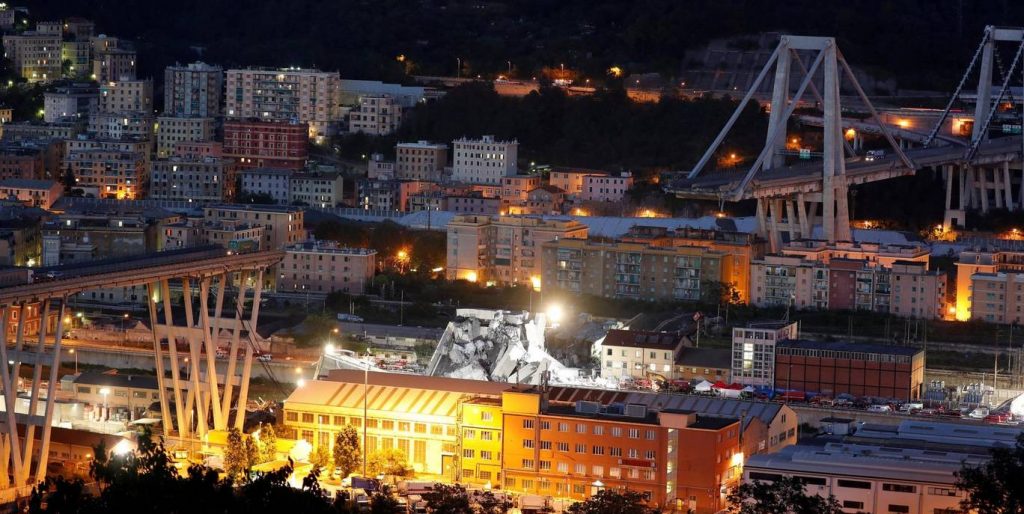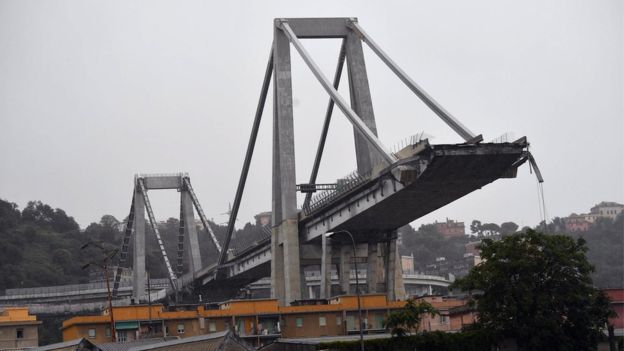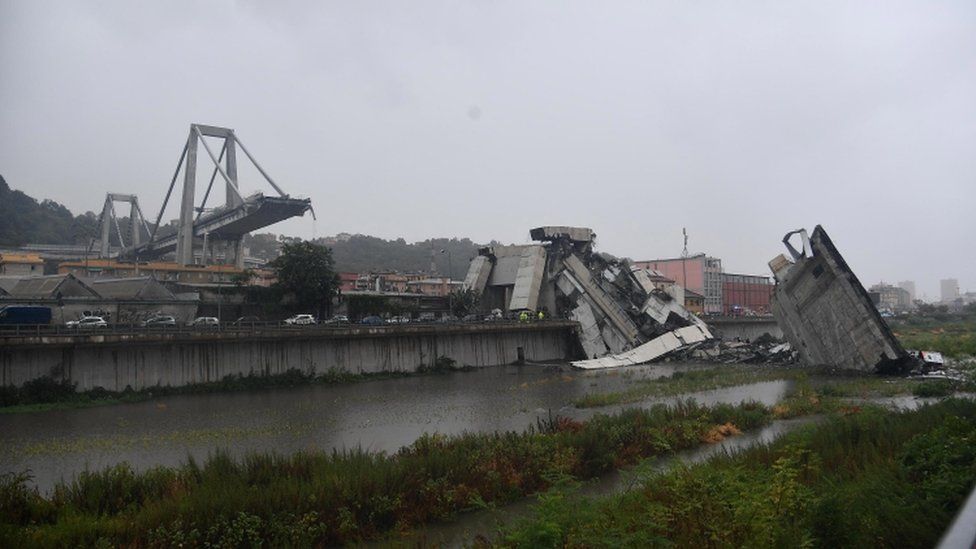Corrosion may have been a factor in the motorway bridge collapse in the northwest Italian city of Genoa in heavy rain that killed and injured dozens of people

Reuters
Between 30 and 35 cars and three heavy vehicles were on the bridge at the time of the collapse, the BBC reported.
It is too early to say what caused the tragic collapse, but as the reinforced and prestressed concrete bridge has been there for 50 years it is possible that corrosion of tendons or reinforcement may be a contributory factor, a UK expert observes.
“There are no obvious signs to say what specifically triggered the collapse at this time; the fact that there was reported to be a storm at the time may or may not be particularly relevant,” says Ian Firth, Past President of The Institution of Structural Engineers, and a Structural Engineer specialising in bridges.
“In addition, on-going work on the bridge may or may not be partly responsible for the collapse.”
Firth notes that the bridge is a “very unusual” design, very similar to its much larger cousin, the Lake Maracaibo bridge in Venezuela, also designed by Riccardo Morandi and completed 6 years earlier in 1962.
The A-frame towers which support the concrete-encased stay cables combine with V-shaped supports below the deck to create a stiff arrangement which is not common in cable stayed bridges.
This deals with potential unbalanced loads which arise due to the multi-span nature of the structure.
“As yet, there is no evidence to say whether any impact occurred; it is too early to say what triggered the collapse.”
There are a large number of reinforced concrete bridges in Italy, Europe, the US, and Canada with the same age, which are suffering from corrosion of reinforcement and/or pre-stressing tendon, adds Dr Mehdi Kashani, Associate Professor in Structural Mechanics at the University of Southampton.
“Recent research showed that corrosion of reinforcement changes the long-term behaviour of ageing reinforced concrete bridges,” he explains.
“In addition, bridges are constantly subjected to cyclic dynamic loading due highway traffic, wind and/or major/minor earthquake, which will result in fatigue damage in bridge components.”
Kashani believes it is important that the bridge collapsed during a heavy storm.
“Therefore, dynamic wind loading, combined with additional loading due to on-going work on the bride, and reduced capacity due to corrosion and fatigue might be the cause of failure.”
However, he says, there is a need for further detailed investigation to fully understand the cause of failure.
“The bridge engineering research community should take this seriously in their future research to improve the resilience of our infrastructure under extreme loading.”

EPA
Lightning strike
Dr Martin Fullekrug, Reader in the University of Bath’s Department of Electronic & Electrical Engineering, addressed speculation that the collapse may have been caused by a lightning strike.
“Very often, it is quoted that lightning can be as powerful as a nuclear power plant,” he admits.
“Yet, it is normally not pointed out that this power only takes effect over an extremely short amount of time, typically just a few tens of a millionth of a second, such that the impact of lightning often remains quite limited.”
Lightning often has indirect effects, such as on consumer electronics when it strikes unprotected buildings.
“However, in the worst case, it can also have direct effects such as melting metal, ignite forest fires and kill people, animal herds and trees.”
Fullekrug admits that whilst it is perhaps not impossible to think that a lightning strike makes a contribution to such a collapse, it is probably very unlikely to happen.
“Lightning could potentially contribute to a critical fatigue of material.”
For example, the lightning generated heat could result in evaporating water to very high pressure and produce a subsequent crack or burst of critical support material, similar to the bark of a tree disintegrating after a lightning strike.
In theory, in might be also possible that the lightning strikes a critical metal bolt such that its function becomes impaired.
“But again, any such kind of scenarios are rather speculative.”
The most important approach to mitigating damage from lightning strikes is to follow the guidelines for lightning protection as set out by the standardising institution in the respective country.
“These guidelines are normally based on the long-term experience with lightning damage and take into account scientific evidence that is constantly updated, based on new knowledge that is generated,” Fullekrug says.
“In this extreme case, a careful investigation of what might have happened seems to be particularly important to avoid similar scenarios in the future.”

EPA
Beautiful design
The Morandi bridge that collapsed was a beautiful expression of the engineering design, says Dr Maria Rosaria Marsico, senior lecturer in Structural Engineering at the University of Exeter.
“The viaduct includes three cable-stayed spans and a series of minor spans for a total length of about 1182 m,” she explains.
The three largest spans consist of independent cable-stayed structures, each carried by an individual reinforced concrete pier and tower 90 m high.
The longest span that collapsed today was about 210 m long.
“The cable-stayed systems was characterised by the adoption of prestressed concrete stays, a common feature of bridges designed by Riccardo Morandi in the sixties,” she says
“The viaduct was subject to maintenance work since it was built, and in the nineties a complex intervention of repair was carried out involving the installation of conventional steel tendons which are flanking the existing concrete stays.”
Aging infrastructure and its impact on structural integrity and safety should become of prime concern to structural engineers, insists Dr. Demitrios Cotsovos, Associate Professor, Institute of Infrastructure and Environment, Heriot-Watt University.
“The potential impact of the environment and extreme weather conditions (possibly associated with climate change) also needs to be assessed,” he adds.
“The need for monitoring structural performance, understanding the causes of the exhibited collapse and developing reliable assessment methods is essential so that events like this be avoided in the future.”




